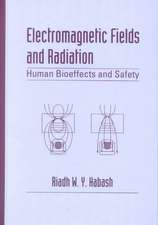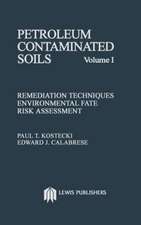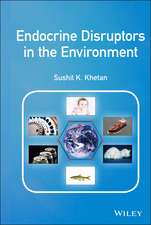Environmental Illness: Myth & Reality
Autor Herman Staudenmayeren Limba Engleză Paperback – 18 dec 2020
What if relief proves elusive-and the patient is sent on a course of ongoing, costly and ineffective ""treatment""?
Several hundred individuals who believed they were suffering from EI have been evaluated or treated by Herman Staudenmayer since the 1970s. Staudenmayer believed the symptoms harming his patients actually had psychophysiological origins-based more in fear of a hostile world than any suspected toxins contained in the environment.
Staudenmayer's years of research, clinical work-and successful care-are now summarized in Environmental Illness: Myth & Reality. Dismissing much of the information that has attempted to defend EI and its culture of victimization, Staudenmayer details the alternative diagnoses and treatments that have helped patients recognize their true conditions-and finally overcome them, often after years of prolonged suffering.
| Toate formatele și edițiile | Preț | Express |
|---|---|---|
| Paperback (1) | 470.20 lei 43-57 zile | |
| CRC Press – 18 dec 2020 | 470.20 lei 43-57 zile | |
| Hardback (1) | 1282.01 lei 43-57 zile | |
| CRC Press – 29 sep 1998 | 1282.01 lei 43-57 zile |
Preț: 470.20 lei
Preț vechi: 553.18 lei
-15% Nou
Puncte Express: 705
Preț estimativ în valută:
89.98€ • 93.41$ • 75.03£
89.98€ • 93.41$ • 75.03£
Carte tipărită la comandă
Livrare economică 24 martie-07 aprilie
Preluare comenzi: 021 569.72.76
Specificații
ISBN-13: 9780367447694
ISBN-10: 036744769X
Pagini: 400
Dimensiuni: 178 x 254 x 21 mm
Greutate: 0.71 kg
Ediția:1
Editura: CRC Press
Colecția Routledge
ISBN-10: 036744769X
Pagini: 400
Dimensiuni: 178 x 254 x 21 mm
Greutate: 0.71 kg
Ediția:1
Editura: CRC Press
Colecția Routledge
Public țintă
Academic and Professional Practice & DevelopmentCuprins
1 What is ""environmental illness""? -- What it is not -- Examples of what it is -- Definitions -- Naming the indefinable -- Idiopathic environmental intolerances -- Clinical ecology and EI advocates -- Prevalence -- Philosophy of science -- Competing theories of EI -- Toxicogenic theory -- History of EI -- Causal agents -- Biological mechanisms and susceptibility -- Explaining psychological symptoms -- Unique principles of toxicology -- Politics -- EI patients -- Symptoms -- Strength of belief in EI -- Personality and behavioral characteristics -- Psychogenic theory -- Belief -- Stress-response -- Psychiatric disorders -- Treatment -- Conclusion -- 2 Toxicogenic theory -- A tale of misguided exploration -- Postulates -- Threshold of onset: total body load -- Long-term effects -- Sensitization -- One-molecule effect -- Heightened sensation: hyperosmia and cacosmia -- Threshold variability -- Sensitivity to multiple environmental agents -- Tune course of a hypersensitivity reaction -- Variability of effects -- Addiction to exposure -- Auxiliary postulates, the protective belt -- Temporal cohesiveness -- Demographic diversity -- Route of exposure -- Dose dependence -- Individual variability, uniqueness -- Rapid onset and cessation of symptoms -- Hypothesized biologic mechanisms -- Limbic kindling -- Tune-dependent sensitization -- Smell and taste -- Conclusion -- 3 Unsubstantiated diagnoses and treatments -- Unsubstantiated diagnostic and treatment practices -- Provocation-neutralization testing -- Sauna depuration -- Imprinted water and EMF -- Inappropriate use of diagnostic methods -- Radiology brain-imaging tests -- Neuropsychological testing -- Self-report of psychological symptoms -- Inappropriate use of treatment methods -- Acupuncture -- Diagnoses incorrectly attributed to EI -- Attention deficit/hyperactivity disorder -- Candida albicans hypersensitivity, the ""yeast connection"" -- Conclusion -- 4 Studies supporting the psychogenic theory -- Demographics and psychiatric/psychological conditions -- Clinical case reports -- Brodsky -- Stewart and Raskin -- Selneretal -- Terr -- Fiedler, Maccia, and Kipen -- Altenkirch, Hopmann, Brockmeier, and Walter -- Witorsch, Ayesu, Balter, and Schwartz -- Black -- Case-control studies -- Pearson, Rix, and Bentley -- Simon, Katon, and Sparks -- Simon, Daniell, Stockbridge, Claypoole, and Rosenstock -- Black, Rathe, and Goldstein -- Staudenmayer, Selner, Buhr, and Selner -- A cohort study of chronic fatigue -- Perplexing questions -- Why middle-age? -- Why female prevalence? -- Symptoms without disease? -- 5 Assessment of the toxicogenic research program -- Critical reports from medical associations -- Junk science excluded from the courtroom -- Testable hypotheses: provocation challenges -- A protocol for provocation chamber challenges -- The challenge chamber -- Methods of blinding the exposure -- Statistical analysis -- The case of a true positive responder -- Controlled challenges with EI patients -- Challenges unanswered -- Conclusion -- 6 Psychogenic theory -- A disorder of belief -- Psychogenic and psychosomatic illnesses -- Psychogenic illness mistaken as asthma -- The sick role -- History of psychogenic illness: neurasthenia -- Primary and secondary gain -- Discussion -- 7 Placebo and somatization -- Definitions -- The placebo effect as nuisance -- Placebo, ritual, and provocation challenges -- Factors contributing to the placebo effect -- Food intolerance: physiology and immunology -- Somatoform disorders -- Hypochondriasis -- Somatization disorder -- Conversion disorder -- An EI case of pseudoseizure -- Conclusion -- 8 Learned sensitivity -- Pavlovian classical conditioning -- Animal conditioning of the immune system -- Conditioning after documented exposure -- Thinking and learning -- Conditioning onset of asthma -- Cognitive learning -- 1886 historical example -- Learning to control allergies -- Fear and anxiety -- Learning and phobia -- The psychodynamics of phobia -- Discussion -- 9 The stress-response -- Hypothalamic-pituitary-adrenal axis -- Psychologic effects of AC1H and corticosteroids -- Stress and aging: the glucocorticoid cascade hypothesis -- Role of psychological factors -- Catecholamine system -- Norepinephrine -- Epinephrine -- Dopamine -- Pupillary reflex -- Autonomic nervous system -- Inhibitory systems -- Serotonin -- GABA -- Opioids and endorphines -- Psychoneuroimmunology -- Effects of the stress-response on cognition -- Conclusion -- 10 Panic attacks and anxiety disorders -- Psychophysiological theories of emotion -- Anxiety -- Panic attack -- Panic disorder -- Trme course -- DSM-IV criteria for PTSD -- Experimental models of PTSD -- Learned helplessness -- Trme-dependent sensitization -- Hyperosmia or cognitive priming? -- Conclusion -- 11 Trauma and post-traumatic stress disorder -- War -- Epidemiology -- Psychophysiology -- Cognitive dysfunction -- Pre-war risk factors -- Childhood trauma and adult sequelae -- Childhood emotional deprivation -- Childhood physical abuse -- Childhood sexual abuse -- A case of sexual abuse and EI -- Neurobiologic effects of childhood sexual abuse -- Conclusion -- 12 The limbic system and trauma -- The limbic system -- Electrical stimulation of emotion -- Emotions activate the limbic system -- Reticular activating system -- Disruptive effects of trauma -- Limbic system symptoms -- PTSD, limbic abnormalities, and trauma -- Hippocampal abnormalities -- EEG abnormalities -- Developmental stage and vulnerability -- Conclusion -- 13 Personality disorders -- Depression as a symptom -- Personality -- Psychological defense mechanisms -- Personality disorders -- DSM-IV Axis II classification -- Self-management of explosive affect -- Self-management of implosive affect -- A case of folie a deux -- Dimensional models of personality -- Limitations of categorical diagnoses -- Dimensional diagnostic approaches -- Discussion -- 14 Iatrogenic illness: exploitation and harm -- A medical cult -- Quacks -- Patient vulnerability -- Devotion to the guru -- Bias and expectation invalidate provocation challenges -- Doctor's expectation and treatment outcome -- Counterphobic rituals and obsessive-compulsiveness -- State revokes license of mercury amalgam guru -- Harmful effects -- The lady in the desert -- Isolation and ineffective rituals -- Munchausen syndrome by proxy -- Where are the bodies? -- Discussion -- 15 Treatment -- The path of psychotherapy -- Difficult patients and resistance -- Transference and countertransference -- Hateful and dangerous patients -- A depth model for selecting an intervention strategy -- Trust, empathy, and rapport -- An exposure event as an organizing concept -- Pitfalls -- The environmental care unit as a sanctuary -- Hope, magic, and the art of healing -- Psychotherapeutic interventions -- Stress management -- Behavior modification: systematic desensitization -- EI case-report involving desensitization -- Cognitive-behavioral therapy -- Cognitive distortions -- Dichotomous thinking -- Selective abstraction -- Arbitrary inference -- Circular logic -- Overgeneralization -- Undergeneralization -- Catastrophizing -- Decatastrophizing -- Misattributed causality -- Rationalization of lies -- Restructuring beliefs -- Psychodynamic psychology -- Treatment of personality disorders -- Psychotropic medications -- Discussion -- 16 Politics -- Victims and a herd of sacred cows -- Blaming social ills -- Reasonable accommodations? -- Victims: a neglected population? -- Politics of intimidation and the law -- Unrealistic product safety regulations -- ""More research"" -- Conspiracy theories -- Media -- Manufacturing industry -- Insurance industry -- Radical politics -- Discussion -- 17 Future directions -- TILT -- Scientific honesty -- The personal factor in disposing of contradiction -- Adversaries -- Paradigm shifts -- Endless rhetoric -- Model for a progressive research program -- Objective measurement and biomarkers -- Predicted outcomes for competing theories -- True positive -- False negative -- True negative -- False positive -- Conclusion -- Appendix A. A methodology of scientific research programs -- Appendix B. Court rulings
Recenzii
"…courageous book in an attempt to investigate and debunk the 'myth of environmental illnesses'…This book is very timely in contributing to this debate."
--Vivien Swanson, in Progress in Environmental Science
Promo Copy
"This is a passionate book. Dr. Staudenmayer is deeply concerned for the welfare of people alleged to suffer from (environmental illness)... He is a true advocate for his patients. His book is worth very serious consideration."
-from the foreword by Henry N. Claman, M.D., Distinguished Professor of Medicine and Immunology, University of Colorado School of Medicine
"...The book combines scientific thoroughness and strong personal convictions. Drawing upon a vast data bank of research statistics, clinical trial results, and personal case studies, the author presents a compelling case in favour of the psychogenic theory...this book has something for everyone."-Euroabstracts, April 1999
"…courageous book…to investigate and debunk the "myth of environmental illness..This book is very timely…"
Progress in Environmental Science
--Vivien Swanson, in Progress in Environmental Science
Promo Copy
"This is a passionate book. Dr. Staudenmayer is deeply concerned for the welfare of people alleged to suffer from (environmental illness)... He is a true advocate for his patients. His book is worth very serious consideration."
-from the foreword by Henry N. Claman, M.D., Distinguished Professor of Medicine and Immunology, University of Colorado School of Medicine
"...The book combines scientific thoroughness and strong personal convictions. Drawing upon a vast data bank of research statistics, clinical trial results, and personal case studies, the author presents a compelling case in favour of the psychogenic theory...this book has something for everyone."-Euroabstracts, April 1999
"…courageous book…to investigate and debunk the "myth of environmental illness..This book is very timely…"
Progress in Environmental Science
Descriere
Environmental illness: certain health professionals and clinical ecologists claim it impacts and inhibits 15 percent of the population. Its afflicted are led to believe environmental illness (EI) originates with food, chemicals, and other stimuli in their surroundings -as advocates call for drastic measures to remedy the situation.
What if relief proves elusive-and the patient is sent on a course of ongoing, costly and ineffective "treatment"?
Several hundred individuals who believed they were suffering from EI have been evaluated or treated by Herman Staudenmayer since the 1970s. Staudenmayer believed the symptoms harming his patients actually had psychophysiological origins-based more in fear of a hostile world than any suspected toxins contained in the environment.
Staudenmayer's years of research, clinical work-and successful care-are now summarized in Environmental Illness: Myth & Reality. Dismissing much of the information that has attempted to defend EI and its culture of victimization, Staudenmayer details the alternative diagnoses and treatments that have helped patients recognize their true conditions-and finally overcome them, often after years of prolonged suffering.
What if relief proves elusive-and the patient is sent on a course of ongoing, costly and ineffective "treatment"?
Several hundred individuals who believed they were suffering from EI have been evaluated or treated by Herman Staudenmayer since the 1970s. Staudenmayer believed the symptoms harming his patients actually had psychophysiological origins-based more in fear of a hostile world than any suspected toxins contained in the environment.
Staudenmayer's years of research, clinical work-and successful care-are now summarized in Environmental Illness: Myth & Reality. Dismissing much of the information that has attempted to defend EI and its culture of victimization, Staudenmayer details the alternative diagnoses and treatments that have helped patients recognize their true conditions-and finally overcome them, often after years of prolonged suffering.













